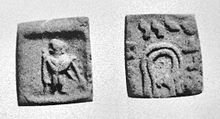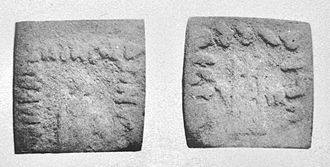- Dionysios Soter
-
Dionysios Soter Indo-Greek king 
Coin of Dionysios SoterReign 65 BCE - 55 BCE Dionysios Soter "Saviour" was an Indo-Greek king in the area of eastern Punjab.[1]
Contents
Reign
According to Osmund Bopearachchi, he reigned ca circa 65 - 55 BCE and inherited the eastern parts of the kingdom of the important late ruler Apollodotus II. The kings share the same epithet and use the common reverse of fighting Pallas Athene, and it seems plausible that they were closely related, but relationships between the last Indo-Greek kings remain uncertain since the only sources of information are their remaining coins. R C Senior dates him approximately ten years later.
Earlier scholars like Professor Ahmad Hasan Dani have dated Dionysius much earlier, between the years 115 and 100 BCE, making him the ruler of the Swat and Dir Valleys and the weak successor of Polyxenos.
Dionysius was probably pressured by the invasions of the Indo-Scythians, and also had to deal with Hippostratos, a more important king who had inherited the western part of the kingdom of Apollodotus II.
Dionysios' name echoes the Olympic wine-god Dionysos, who according to Greek mythology was also an ancient king of India.
Coins of Dionysius
Dionysius was the first in the line of late kings who issued only silver drachms, but no tetradrachms, which was likely due to his limited resources. On their obverse is a diademed portrait of the king, with Athena Alkidemos on the reverse.
He also issued bronzes with Apollo on the reverse and a tripod on the obverse. Both these types were inherited from Apollodotus II. The quality of the portraits is inferior to most earlier kings. According to Bopearachchi, Dionysius inherited only the inferior celators of Apollodotus II, which he associates with mints in eastern Punjab.
Notes
Preceded by:
Apollodotus IIIndo-Greek Ruler
(Eastern Punjab)
(65 - 55 BCE)Succeeded by:
Zoilos IIINDO-GREEK KINGS AND THEIR TERRITORIES
Based on Bopearachchi (1991)Territories/
DatesPAROPAMISADE ARACHOSIA GANDHARA WESTERN PUNJAB EASTERN PUNJAB 200-190 BCE Demetrius I 
190-180 BCE Agathocles 
Pantaleon 
185-170 BCE Antimachus I 
180-160 BCE Apollodotus I 
175-170 BCE Demetrius II 
160-155 BCE Antimachus II 
170-145 BCE Eucratides 
155-130 BCE Menander I 
130-120 BCE Zoilos I 
Agathokleia 
120-110 BCE Lysias 
Strato I 
110-100 BCE Antialcidas Heliokles II 
100 BCE Polyxenios 
Demetrius III 
100-95 BCE Philoxenus 
95-90 BCE Diomedes 
Amyntas 
Epander 
90 BCE Theophilos 
Peukolaos 
Thraso 90-85 BCE Nicias 
Menander II 
Artemidoros 
90-70 BCE Hermaeus 
Archebios 
Yuezhi tribes Maues (Indo-Scythian) 75-70 BCE Telephos 
Apollodotus II 
65-55 BCE Hippostratos 
Dionysios 
55-35 BCE Azes I (Indo-Scythian) Zoilos II 55-35 BCE Apollophanes 
25 BCE- 10 CE Strato II & III 
Rajuvula (Indo-Scythian) See also
- Greco-Bactrian Kingdom
- Seleucid Empire
- Greco-Buddhism
- Indo-Scythians
- Indo-Parthian Kingdom
- Kushan Empire
References
- "Monnaies Gréco-Bactriennes et Indo-Grecques", Osmund Bopearachchi, Bibliothèque Nationale de France.
- "The Bactrian and Indus-Greeks", Prof. Ahmed Hasan Dani, Lahore Museum.
- "The Indo-Greeks Revisited and Supplemented", Dr. A.K. Narain, BR Publishing Corporation.
Categories:- Indo-Greek kings
- 1st-century BC Asian rulers
Wikimedia Foundation. 2010.

